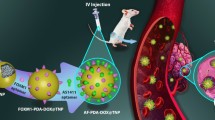Abstract
Cis-diaminechloro-[2-(diethylamino) ethyl 4-amino-benzoate, N4]-chloride platinum (II) monohydrochloride monohydrate (DPR) is a monofunctional Pt triamine complex synthesized starting from cisplatin and procaine hydrochloride, characterized by a good antitumor activity coupled with low toxic effects and able to impair prenatal development of mice but at doses outside or just in the upper range of therapeutic doses. In the present paper the transplacental passage of DPR-derived Pt was investigated in CD1 mice on days 9, 13, 16 and 18 of pregnancy, 24 h after ip administration of 21 mg/kg DPR. For comparison, groups of mice were treated with an equivalent Pt-containing dose of cisplatin (10.7 mg/kg). Similarly to cisplatin, small amounts of Pt were detected in fetuses on day 9. From day 13 of gestation the concentration of DPR- and cisplatin-derived Pt increased up to the highest fetal concentrations detected on day 16. On day 18 the concentration of Pt decreased. Most importantly, on days 13–18 of pregnancy cisplatin-derived Pt was always significantly higher than that assayed after DPR administration. In addition, on day 13 of pregnancy Pt exposure of fetuses was significantly higher when dams were treated with cisplatin (AUC0.5–24= 3.40 vs. 4.95 μg·h/g). Finally, it is worth noting that serum decay of Pt after DPR or cisplatin administration in adult female mice was similar with AUC0.13–2h s of 7.5 and 6.6 μg·h/ml, respectively. When we determined the concentration of Pt into the main organs of fetuses from dams treated with either DPR or cisplatin on day 18 of gestation, we observed a different organ distribution. In fact, while the concentration of DPR-derived Pt was greater in the heart (1.08±0.30 vs. 0.78±0.35 μg/g, p <0.10), an opposite situation was found in the kidney (0.51±0.20 vs. 0.69±0.22 μg/g, p <0.05). In conclusion, our data show that DPR may pass through the placenta with an efficiency significantly lower than that of cisplatin. This finding may represent one of the possible causes of the lower embryotoxic/teratogenic effect of DPR as compared to cisplatin.



Similar content being viewed by others
References
Cafaggi S, Esposito M, Parodi B, Vannozzi MO, Viale M, Pellecchia C, Fulco RA, Merlo F, Zicca A, Cadoni A, Bignardi G (1992) Synthesis and antitumour activity of a new cis-diammineplatinum(II) complex containing procaine hydrochloride. Anticancer Res 12:2285–2292
Fulco RA, Vannozzi M, Collecchi P, Merlo F, Parodi B, Civalleri D, Esposito M (1990) Effect of normal saline on cisplatin pharmacokinetics and antitumor activity in mice bearing P388 leukemia. Anticancer Res 10:1603–1610
Giavini E, Lemonica IP, Lou Y, Broccia ML, Prati M (1990) Induction of micronuclei and toxic effects in embryos of pregnant rats treated before implantation with anticancer drugs: cyclophosphamide, cis-platinum, adriamycin. Teratogenesis Carcinog Mutagen 10:417–426
Keller KA, Aggarwal SK (1983) Embryotoxicity of cisplatin in rats and mice. Toxicol Appl Pharmacol 69:245–256
Köpf-Maier P (1983) Stage of pregnancy-dependent transplacental passage of 195Pt after cis-platinum treatment. Eur J Cancer Clin Oncol 19:533–536
Lazar R, Conran PC, Damjanov I (1978) Embryotoxicity and teratogenicity of cis-diamminedichloroplatinum. Experientia 35:647–648
Mandys V, Viale M, Cafaggi S, Esposito M (1998) Neurotoxic effect of cisplatin and the cisplatin-procaine complex DPR studied in organotypic cultures of chick embryonic dorsal root ganglia. Anti-Cancer Drugs 9:659–663
Mariggiò MA, Cafaggi S, Ottone M, Parodi B, Vannozzi MO, Mandys V, Viale M (2004) Inhibition of cell growth, induction of apoptosis and mechanism of action of the novel platinum compound cis-diaminechloro-[2-(diethylamino) ethyl 4-amino-benzoate, N4]-chloride platinum (II) monohydrochloride monohydrate. Invest New Drug 22:3–16
Ognio E, Lapide M, Ottone M, Mandys V, Peterka M, Parodi B, Viale M (2003) Embryo-lethal and teratogenic effect of the new platinum compound DPR in pregnant mice. Arch Toxicol 77:584–590
Pastrone I, Viale M, Cafaggi S, Mariggiò MA, Parodi A, Esposito M (1999) Effect of the cisplatin-procaine complex DPR in combination with several anticancer agents on murine P388 leukemic cells in vitro and in vivo. Invest New Drugs 16:297–302
Peterka M, Mandys V, Viale M, Cafaggi S, Peterková R, Esposito M (2002) Embryotoxicity of cisplatin and a cisplatin-procaine complex (DPR) studied in chick embryo. Neoplasma 49:394–400
Viale M, Cafaggi S, Parodi B, Esposito M (1995) Cytotoxicity and cellular accumulation of a new cis-diammineplatinum(II) complex containing procaine in murine L1210 cells sensitive and resistant to cis-diamminedichloroplatinum (II). Cancer Chemother Pharmacol 35:371–376
Viale M, Vannozzi MO, Merlo F, Cafaggi S, Parodi B, Esposito M (1996) Cisplatin combined with the new cisplatin-procaine complex DPR: in vitro and in vivo studies. Eur J Cancer 32A:2327–2333
Viale M, Pastrone I, Pellecchia C, Vannozzi MO, Cafaggi S, Esposito M (1998) Combination of cisplatin-procaine complex DPR with anticancer drugs increases cytotoxicity against ovarian cancer cell lines. Anti-Cancer Drugs 9:457–463
Zhang JG, Esposito M, Cafaggi S, Lindup WE (1996) Comparison of the toxicities of cisplatin and a new cisplatin-procaine complex to rat renal cortical slices. Hum Exp Toxicol 15:59–63
Author information
Authors and Affiliations
Corresponding author
Rights and permissions
About this article
Cite this article
Ognio, E., Chiavarina, B., Caviglioli, G. et al. Transplacental passage of Pt after treatment with the new triamine complex cis-diaminechloro-[2-(diethylamino) ethyl 4-amino-benzoate, N4]-chloride platinum (II) monohydrochloride monohydrate. Arch Toxicol 78, 584–588 (2004). https://doi.org/10.1007/s00204-004-0576-x
Received:
Accepted:
Published:
Issue Date:
DOI: https://doi.org/10.1007/s00204-004-0576-x




